#archivespace
Explore tagged Tumblr posts
Text
Can’t do my archivist job bc archivespace is down so now I’m just fuckin sittin here

#kj is struggling y’all#I just finished my tasks that didn’t require archivespace#and then as soon as I finished them archivespace said byeee
1 note
·
View note
Text
Übung Vergleich von ArchivesSpace und Access to Memory (AtoM)
ArchiveSpace und Access to Memory (AtoM) sind zwei Open-Source-Archivskatalogssoftware. Sie sind sich sehr ähnlich, da sie die gleichen Ziele verfolgen: einer Bibliothek ein Online-Archiv zur Verfügung zu stellen. Beide basieren auf den ISAD(G)-Standards mit die verschiedenen Stufen, die leicht zu erkennen sind ("Dossier", "Fonds" usw.) und nach denen wir bei jeder Integration neuer Elemente gefragt werden. Ich bevorzuge jedoch AtoM aus verschiedenen Gründen. Zunächst einmal finde ich AtoM viel intuitiver. Ich habe nur ein paar Minuten gebraucht, um zu verstehen, wie man die verschiedenen Ressourcen in einem einzigen Archiv zusammenfügt. Bei ArchiveSpace hingegen musste ich mehrere Tests durchführen und mit den anderen Fonds vergleichen, die es bereits auf der Plattform gibt. Außerdem finde ich die Oberfläche von AtoM ästhetisch ansprechender und responsiv gestaltet. Die anklickbaren Buttons sind groß genug, klar und intelligent platziert. Zum Beispiel ist die Suche von der Erstellung von Ressourcen, Institutionen usw. in der Taskleiste getrennt. Das klingt vielleicht harmlos, aber für mich sind es solche Details, die dafür sorgen, dass man sich nicht im Programm verliert. Dies führt zu einer nicht zu unterschätzenden Zeitersparnis. Dasselbe gilt für den Import/Export: Bei AtoM ist die Funktion an jeder Stelle, an der Sie Ressourcen erstellen oder abrufen, deutlich sichtbar. Bei ArchiveSpace ist dieselbe Funktion hingegen schwer zu finden, wenn man nicht weiß, wo sie sich befindet. Mir ist auch eine Verwirrung mit den Begriffen aufgefallen. Eine "Ressource" in ArchiveSpace ist eine " Description" in AtoM. Dennoch verwenden beide Programme denselben Begriff für "Accession". Das führt zu Verwirrung und es wäre schön, wenn mit jedem Programm ein kleines Handbuch und/oder eine Liste mit Definitionen für jeden Begriff verfügbar wäre. Die einzigen Tutorials, die ich auf AtoM finden konnte, sind hauptsächlich technischer Natur und beziehen sich nur auf die Installation... Man kann also feststellen, dass es an erklärenden Ressourcen für beide Programme mangelt. Man kann nur hoffen, dass, wenn man eines der beiden Programme für unser Archivzentrum verwenden möchte, eine erklärende, relevante und für Techniker UND Bibliothekare geeignete Dokumentation zur Verfügung gestellt wird.
0 notes
Text
Vorlesung 6 Funktion und Aufbau Archivsystemen & Übung
Ablauf der Einheit:
Metadatenstandards in Archiven
ArchivesSpace
Archivsysteme
Auf den Sinn und Zweck von Metadatenstandards muss nicht mehr eingegangen werden, da dies schon in den letzten beiden Vorlesungen besprochen wurde
Metadatenstandards in Archiven – ISAD(G) und EDA
Es war interessant wieder einmal über ISAD(G) zu hören. In meiner Ausbildung in Deutschland zur Fachangestellten für Medien- und Informationsdienste wurde das katalogisieren von Archivgut nach ISAD(G) unterrichtet und wir mussten die Felder auswendig lernen. Es war spannend zu sehen, wie viel davon mir noch im Gedächtnis verblieben ist, im Studium wurde es in vergangenen Vorlesungen auch kurz angesprochen, jedoch nur oberflächlich. Aufgrund der Neugierde habe ich nach der Vorlesung auch meine alten Unterlagen aus der Berufsschule nach meinen Aufzeichnungen davon durchsucht.
ISAG(G) – das Archivregelwerk
Die Abkürzung steht für* International Standard Archival Description (General)* und ist ein internationaler Standard zur Verzeichnung von Archivalien. Die erste Fassung wurde 1993/94 veröffentlicht, die zweite Fassung 2000. Die zweite Fassung ist auch heute noch in Verwendung. ISAD(G) kann, ähnlich wie RDA, auch in Verbindung mit anderen Standards genutzt werden. Da es ein Internationaler Standard ist, dient er auch zum internationalen Austausch von Verzeichnungsinformationen. Ein weiterer Vorteil ist, dass er ungeachtet der Form und des Mediums angewendet werden kann. Die Datenstruktur orientiert sich an den früheren analogen Findmitteln wie Findbücher und Zettelkästen. ISAD(G) nutzt das Provienienzprinzip, das heisst es wird abgebildet nach Entstehungszusammenhang. Dabei wird auf mehreren Ebenen verzeichnet.
Kurzer Ausflug da ich es immer wieder vergesse: Provenienzprinzip: Archivalien werden nach ihrer Entstehung und ihrer Herkunft geordnet. Pertinenzprinzip: Archivalien werden nach Themenfeldern (Sachverhalten/Ereignissen/Personen) geordnet.
Bereiche und Verzeichnungselemente:
Es gibt 7 Verzeichnungselementgruppen:
Identifikation (Signatur etc.)
Kontext (Herkunft, Geschichte etc.)
Inhalt und Ordnung (Form und Inhalt, Bewertung etc.)
Zugangs- und Benutzungsbedingungen (Sprache, Schrift, Findmittel)
Sachverwandte Unterlagen (Aufbewahrungsort Originale, Kopien etc.)
Anmerkungen
Kontrolle (Bearbeiter etc.)
Weiter existieren sechs Pflichtfelder, welche bei der Verzeichnung ausgefüllt werden müssen:
Signatur
Titel
Provenienz
Entstehungszeitraum
Umfang
Verzeichnungsstufe
Ob und wie etwas verzeichnet werden muss ist immer auch abhängig von der Stufe, folgende Stufen gibt es (vom Großen ins Kleine):
Archiv
Bestand
Serie
Akte/Dossier
Dokument
Weitere Informationen hierzu sind unter der Schweizerischen Richtlinie für die Umsetzung von ISAD(G) zu finden unter folgendem Link.
ISAAR(CPF)
Beim International Standard Archival Authority Record for Corporate Bodies, Persons and Families handelt es sich um einen Standard für Normdateien. Da hier der Verzeichnisaufwand relativ hoch ist, wird dieser Standard nur selten verwendet. Er soll die Verbindung zwischen Urhebern und Unterlagen schaffen. Dabei ist er international verwendbar und schafft die Möglichkeit, Kontext und Inhalt von Archivgut getrennt zu verwalten[1].
Übung zu AtoM und ArchivesSpace
Es sollte nun auch ein Eintrag zur Übung zum Vergleich von AtoM und ArchiveSpace gemacht werden. Verglichen werden sollten die Verwaltungs- und Veröffentlichungsfunktionen.
AtOM
Atom ist ein webbasiertes und quelloffenes System. Das System ist von dem Metadatenstandard auf ISAD(G) aufgebaut. Es gibt leider leider keine deutsche Übersetzung.
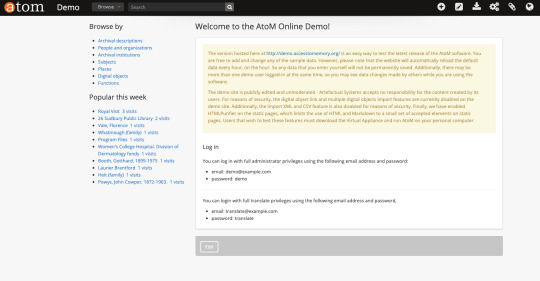
Es gibt eine Demo-Version, welche für den Vergleich genutzt wurde.
Suche
Wenn man sich eingeloggt hat, kann man über das Suchfeld in der Mitte suchen. Dabei kann man nach Sprachen, Instituten etc. suchen. Weiter gibt es eine erweiterte Suche. Ich finde alles sehr intuitiv zu bedienen.
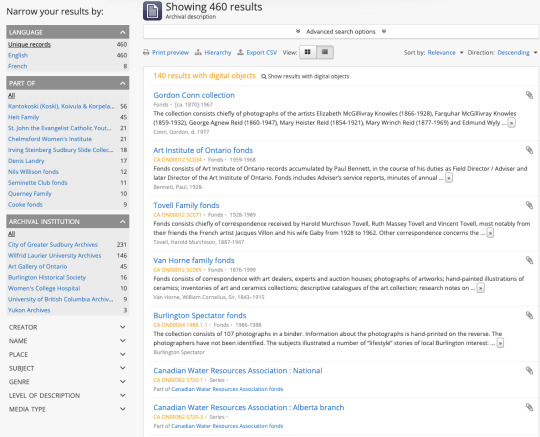
Katalogisieren
Für das Erfassen bzw. katalogisieren war ich für einen Moment ein wenig unsicher, was ich machen muss. Klickt man über das + in der Ecke auf "Accession Record", so kann man einen neuen Datensatz erfassen. Pflichtfelder sind mit Sternchen markiert. Wenn man weiter möchte, muss man auf die eingeklappten Abschnitte klicken.
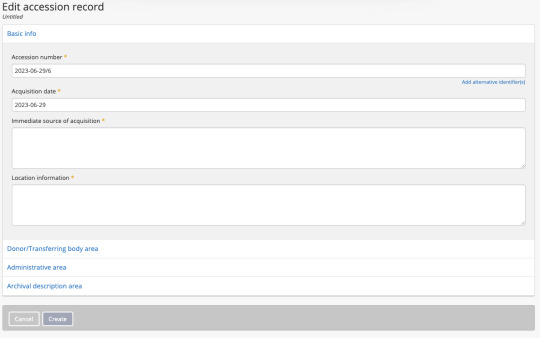
ArchivesSpace
ArchivesSpace ist eine Open-Source-Software, bei welcher man auch bezahlen kann, um mehr Funktionen und Vorteile zu haben. Wie auch AtoM basiert ArchivesSpace auf den Standards ISAD(G), DACS und ISAAR(CPF). Das System hat leider noch keine deutsche Übersetzung.
Ich habe für den Vergleich die Sandbox-Version genutzt.
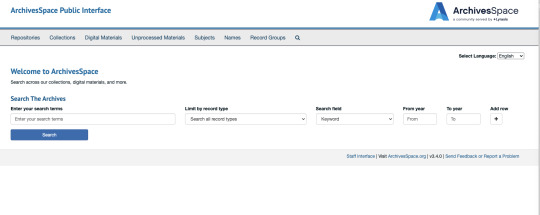
Suche
Für die Suche hat man etwas weniger Möglichkeiten wie bei Atom. Toll ist aber, dass man die Sprache auf Deutsch einstellen kann. Man kann zwischen Suchbegriffen, Art, Schlagworten und Jahr auswählen. Man kann auch weitere Zeilen mit und/oder Verknüpfungen hinzufügen. Die Anzeige der Suchergebnisse ist sehr ähnlich wie bei AtoM

Katalogisieren
Zum Katalogisieren klickt man bei ArchivesSpace auf "Select Create" und fügt dann ein neues Katalogisat hinzu. Auch hier werden Pflichtfelder mit Sternchen gekennzeichnet. Im Gegensatz zu AtoM, wo die einzelnen Felder aufgeklappt werden müssen, hat man hier auf der linken Seite ein Menü, bei welchem man die Kategorien auswählen kann. Die Möglichkeiten beim katalogisieren ist sehr gross, d.h. man kann es sehr ausführlich machen.

Quelle Foto: https://rs4.reuther.wayne.edu/SuperManual/01_accessioning/01_02_archivesspace_accessions/
Fazit:
Mir gefallen beide Systeme in grossen und ganzen gut. Ich finde auch wenn sie teilweise andere Funktionen/Workflows haben, ähneln sie sich.
0 notes
Text
Quarantine Tag Game
Tagged by: @jumbled-nonsense, thank you love!
ARE YOU STAYING HOME FROM WORK AND SCHOOL? Yes, I am lucky that I can work from home. It’s a bit of an adjustment as when I’m physically at work most of my job revolves around reference work with walk ins and people who make appointments with us and now I’ve had to switch entirely to the other side of my job (processing) which I haven’t actually gotten to do in a year or so.
IF YOU’RE STAYING HOME, WHO’S THERE WITH YOU? Literally no one, I live alone. I am currently cat-sitting though, so I do have an animal companion. (Follow the “that darn cat” tag on my side blog to see his exploits.)
ARE YOU A HOMEBODY? Yes. So much yes, working from home has done so little to change my routine it’s insane.
AN EVENT THAT YOU WERE LOOKING FORWARD TO THAT GOT CANCELLED? Nothing outright yet, I’ve had a few conferences that I wanted to go to nixed but those were professional opportunities. I am very worried about an upcoming visit that may have to be pushed back though.
WHAT MOVIES HAVE YOU WATCHED RECENTLY? Actually haven’t been watching movies, I guess Maurice? 1987 BBC adaptation. I’m having thinky thoughts.
WHAT SHOWS ARE YOU WATCHING? Roswell New Mexico, of course, and I’ve been catching up on Brooklyn 99. Also Schitt’s Creek and Outlander.
WHAT MUSIC ARE YOU LISTENING TO? My Spotify playlists. I curate them by “vibes” so I had my “Easy Listening” playlist on the other day which is mostly acoustic stuff that I can sing to easily while baking. Then again I sat down to process and put on my playlist of 20teen pop/top 40 which was a BLAST so it depends on my mood lol. (Find me under “archivespace” on Spotify if you really want to I guess.)
WHAT ARE YOU READING? I’ve been catching up on journal articles for work, and fic. I’ve got an actual book I need to read I’ve been borrowing from a friend for MONTHS but I haven’t gotten to it yet.
WHAT ARE YOU DOING FOR SELF-CARE? I wanted chocolate but I was self-isolating because my parents had come through town (long story, they were not travelling for the hell of it though) so I pulled down my recipe book and made chocolate frosting. Twas delicious. Otherwise I try to keep to my normal schedule of showering and cleaning, I do a little yoga to stretch and I go on at least one social distanced walk a week with a local friend.
I won’t tag people but this is a good one!
4 notes
·
View notes
Text
“Grand tour” d'un chartiste. Archives et livres rares
Martin Bugnicourt effectue son stage de 4e année à la British School at Rome.

Figure 1 : Au travail !
Comme j’en avais déjà l’intuition lors de ma première visite des lieux, j’ai vite été conforté dans l’idée que la British School at Rome (BSR, pour faire court) était un environnement de travail particulier. Entièrement dédiée à la recherche, qu’elle soit historique, archéologique ou artistique, cette institution plonge les résidents qu’elle accueille dans un bain de science particulièrement épanouissant. Et, du peu que j’ai pu en expérimenter, après plus d’un mois et demi de stage, l’atmosphère est tout aussi enrichissante pour le personnel qui encadre ces chercheurs.
De mon côté, j’ai surtout côtoyé l’équipe de la bibliothèque et des archives. Sous la direction d’une chartiste, Raphaële Mouren, travaillent les bibliothécaires, Beatrice Gelosia, Francesca Deli (dite Franceschina) et Francesca de Riso, ainsi que l’archiviste, Alessandra Giovenco. C’est l’occasion pour moi de leur adresser mes remerciements les plus chaleureux pour leur accueil et l’expérience qu’elle m’ont transmise. Car, en effet, mon stage à la BSR a fait se rencontrer archivistique et travail de bibliothèque. Si chacune de ces disciplines m’a permis de mener à bien des tâches différentes, elles ont également confirmé mon sentiment, déjà éprouvé lors de précédents stages, qu’elles ne sont pas bien éloignées l’une de l’autre.
Le plus gros chantier de mon stage a été celui du traitement du sous-fonds des Archaeological Excavations records, c’est-à-dire les archives relatives à des fouilles archéologiques impliquant les équipes de la BSR. La plupart des documents regroupés dans ce sous-fonds (le fonds étant celui, plus vaste, de l’Archaeological Archive) ont été produits entre les années 1960 et 1990, et oscillent entre journaux de fouilles, tenus au jour le jour, catalogues de trouvailles et correspondance, le tout rédigé à l’envi en anglais, italien, voire français. Tout est conservé dans le bureau des archéologues, sous clef dans des armoires en métal ou dans des meubles à plans.
Quand j’écris « traitement », c’est un peu un abus de langage : je n’ai pas eu à commencer mon travail à partir de rien. Il existait déjà un inventaire, réalisé dans les années 1990 et révisé en 2002. Il m’est très vite apparu, cependant, qu’entre 2002 et aujourd’hui il y avait eu du mouvement dans les archives. Après avoir parcouru une première fois rapidement le sous-fonds, il m’a donc semblé nécessaire de mettre en place un plan d’attaque. L’objectif que m’avait exposé Alessandra était clair : avancer au maximum la saisie des données de l’inventaire dans ArchiveSpace, l’outil sélectionné par la BSR pour la mise à disposition des lecteurs, en ligne, de la liste de ses fonds. En clair, un instrument de recherche numérique.
Seulement voilà : il eût été dangereux, sinon absurde, de mettre en ligne des informations dont je savais déjà qu’elles étaient erronées, l’inventaire ne correspondant plus parfaitement au sous-fonds tel qu’il se présentait dans les armoires. Il était donc nécessaire, avant toute chose, de faire un récolement. Tâche fastidieuse, comme chaque chartiste le sait, d’autant que le sous-fonds ne comprend pas moins de 59 séries, chacune d’elles correspondant à un site archéologique. Évoquer ces séries est l’occasion de dire un mot du classement du sous-fonds et des séries : les documents y avaient déjà été organisés par typologie (correspondance, carnets de fouilles, catalogues, brouillons de publications, etc.). Je n’ai pas vu l’intérêt de revenir sur cette décision, qui m’est apparue d’autant plus cohérente qu’elle avait été mise en place en respectant les différentes phases de chaque chantier de fouille.
À mesure que le récolement avançait, et me fournissait des bases de travail saines pour un nombre de séries toujours croissant, j’ai pu attaquer la deuxième phase du protocole que je m’étais assigné : la saisie brute sur ArchiveSpace des données de l’inventaire vérifié. Travail très mécanique, mais allant relativement vite, il permettait d’inscrire sur la plateforme – en open source, par ailleurs – des premières données qui pourraient ensuite être retravaillées pour obtenir un résultat harmonieux.

Figure 2 : Les Archaeological Excavation records, dans leur jus
Les dernières étapes de mon travail ne pourront être menées à bien pour chacune des 59 séries, par manque de temps, sinon pour deux d’entre elles qui ont été entièrement parachevées afin de servir de guide à la personne qui reprendra mon travail. Il s’agira de fournir, selon un schéma établi, une description pour chacune des séries – un travail d’autant plus enrichissant qu’il implique de la recherche – et de raffiner les descriptions des documents, en y adjoignant autorités, dates, volumétrie, etc. À terme, lorsque le site sera diffusé – il est pour l’instant en ligne mais le lien n’est pas visible sur le site de la BSR – cela devrait fournir un instrument de recherche assez efficace et facile à appréhender.
À tout cela s’ajoute la perspective de moins en moins lointaine pour le sous-fonds d’un reconditionnement. Certaines des boîtes sont vieilles, potentiellement dangereuses pour les documents, et certaines ne protègent plus leur contenu. Les enveloppes sont, pour beaucoup, surchargées de documents et se déchirent à la moindre manipulation. La première étape, pour ce chantier-là, consistera à obtenir une idée précise de la volumétrie du sous-fonds. La suite, c’est une histoire pour un autre stagiaire !
L’aventure a été bien différente en bibliothèque, mais non moins diversifiée. La première mission que l’on m’a confiée a été l’étude d’un manuscrit. Exceptionnel dans les collections, le Ms32 de son petit nom avait été sommairement décrit pour le fichier, mais jamais véritablement étudié de près. Je me suis donc penché sur son cas. Il s’agit d’un manuscrit du début du XVIIe siècle, un album amicorum réalisé par le graveur Giacomo Lauro : l’artiste y a consigné les lettres que lui envoyaient ses clients les plus prestigieux en remerciement des œuvres qu’ils recevaient, auxquelles il a adjoint des illustrations (des blasons, pour la plupart, mais également quelques peintures de personnages féminins). Passé de main en main (notamment celle d’un marchand français installé à Rome à la fin du XVIIe siècle, qui a jugé bon de faire « restaurer » le livre et d’ajouter des ex-libris un peu partout), ce petit ouvrage est assez insolite, très composite et surtout en état de conservation préoccupant : la reliure, presque complètement défaite, ne participait plus de la sauvegarde de l’unité du livre, et certaines illustrations souffraient du temps. Mon travail s’est donc inscrit dans la perspective de la restauration et de la numérisation du Ms32.
Par chance, j’ai fait partie l’année passée du petit groupe ayant suivi les cours de codicologie dispensés à l’École des chartes. J’ai mis sur pied une notice, en anglais, selon les normes françaises pour les manuscrits du Moyen Âge (en ignorant certains détails ne faisant pas sens dans le cas présent, toutefois, notamment la transcription des incipit et explicit). Ce travail m’a poussé à me familiariser avec le vocabulaire de la codicologie dans une autre langue, et sur ce point les ressources de la bibliothèque ont été précieuses : adieu donc les réclames, les couvertures et la reliure, et bonjour catchwords, bookplates et binding. Une fois la notice codicologique mise sur pied, j’ai, avec la grande aide de ma collègue Beatrice, transcrit une partie des informations sur le catalogue de la bibliothèque afin de créer une notice en ligne pour le manuscrit.
Dans le même temps, j’ai aussi extrait un certain nombre d’informations du manuscrit, très riche. Tout d’abord, les noms des auteurs des lettres consignées dans le Ms32. Il y avait là matière à ne pas s’ennuyer, puisque ce ne sont pas moins de 179 lettres qui débordent de ses pages. Dans une certaine mesure, les personnages étaient identifiables grâce à leur fonction : ainsi se trouvent, dans les premières pages, des missives du pape, de l’empereur, ou du duc de Bavière. Pour la plupart, toutefois, je n’ai dû me contenter que d’un nom retranscrit, et ce sera aux chercheurs qui s’intéresseront au manuscrit de compléter le travail. J’ai appliqué le même procédé pour les innombrables blasons qui colorent l’ouvrage. Le procédé, s’il pouvait parfois aider à identifier un personnage, était toutefois particulièrement complexe dans la mesure où la majeure partie de ces blasons étaient polonais. Or, en plus de mon ignorance crasse du sujet, j’ai dû faire face à la difficulté inhérente à l’armorial polonais qui comporte un nombre relativement limité de blasons, herb en VO, que se partagent parfois plusieurs centaines de familles. Les ressources de la bibliothèque se limitant, cette fois, à quelques manuels d’héraldique relativement généraux, j’ai dû me contenter, dans la grande majorité des cas, d’une description du blason. J’en ai cependant retenu une certaine inventivité dans le domaine au XVIIe siècle !
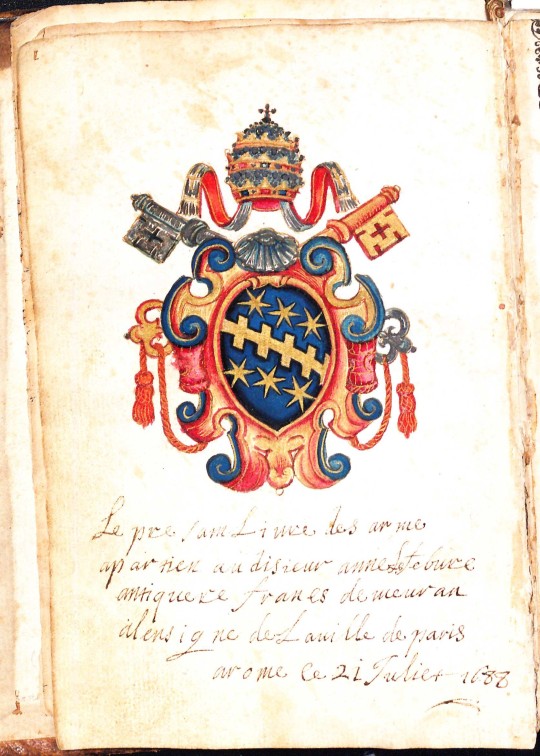
Figure 3 : Les armes de Clément VIII dans le Ms32
La suite du parcours, pour ce manuscrit, est déjà sur les rails à l’atelier de restauration, puis à la numérisation. Il devrait prochainement être visionnable en tant que ressource de la bibliothèque.
Autre aspect de mon travail en bibliothèque : l’initiation au catalogage en MARC. À nouveau, j’ai travaillé sous la bienveillante supervision de Beatrice, qui m’a montré comment s’y prendre avant de me confier une pile d’ouvrages tirés de la réserve des livres rares. Ce sont tous des recueils de gravures, de la fin du XVIIIe siècle ou du début du XIXe, représentant des vues de Rome, de ses alentours, ou des scènes de la vie rurale. Au-delà du plaisir de contempler ces livres (qui me servent presque de guide touristique!), je tire de ce travail qui se fait presque à la chaîne une expérience qui m’habitue à ce que l’on pourrait considérer comme le B.A-BA du travail en bibliothèque.
Alors, pour dire quelques mots de conclusion sur ce bilan de mon travail à la BSR, je voudrais me répéter : archives et bibliothèques se ressemblent et s’assemblent bien plus que ne le laisseraient croire les spécialisations vers lesquelles nous sommes poussés dans notre formation. J’ai trouvé dans le catalogage en bibliothèque et dans la saisie de données en archives des similarités très fortes, et des problématiques identiques, ne serait-ce qu’au niveau de l’identification d’autorités permettant d’accéder à l’information. J’ajoute à cela que la bibliothèque nourrit la recherche nécessaire au travail de l’archiviste, et que les archives, par leur caractère unique, complètent de façon essentielle les ressources dont disposent les chercheurs en bibliothèque. Des observations qui n’ont rien de révolutionnaire, en somme, mais qui mettent en lumière la richesse de cet environnement de travail qu’est la BSR, où archives et bibliothèque ne sont séparées que par un couloir.
0 notes
Text
i did it. @archivespace
i will not make a gradblr i will not make a gradblr i will not make a gradblr i will not make a gradblr i will not make a gradblr i will not make a gradblri will not make a gradblr i will not make a gradblr i will not make a gradblri will not make a gradblr i will not make a gradblr i will not make a gra
#grad school#gradblr#i am weak#no guarantees on posting because this semester is shaping up to be hectic
33 notes
·
View notes
Photo
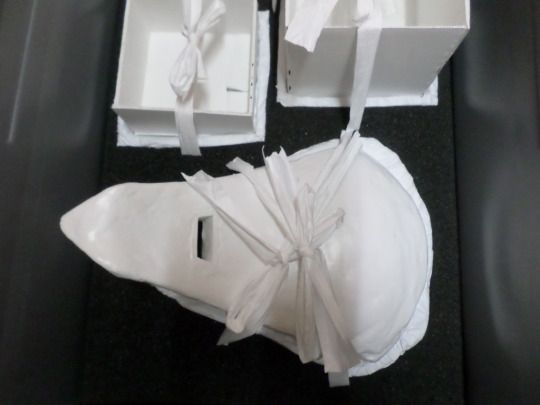
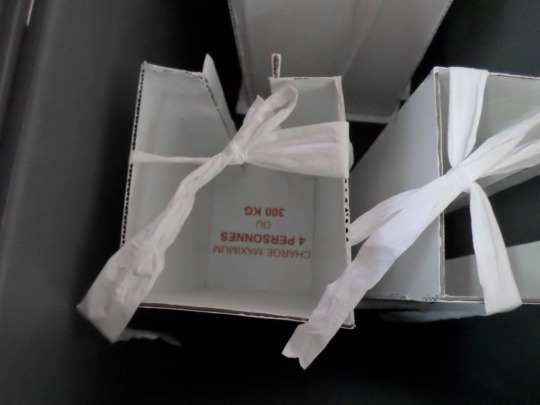
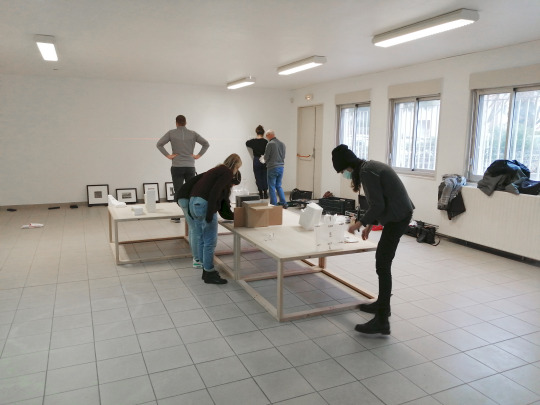

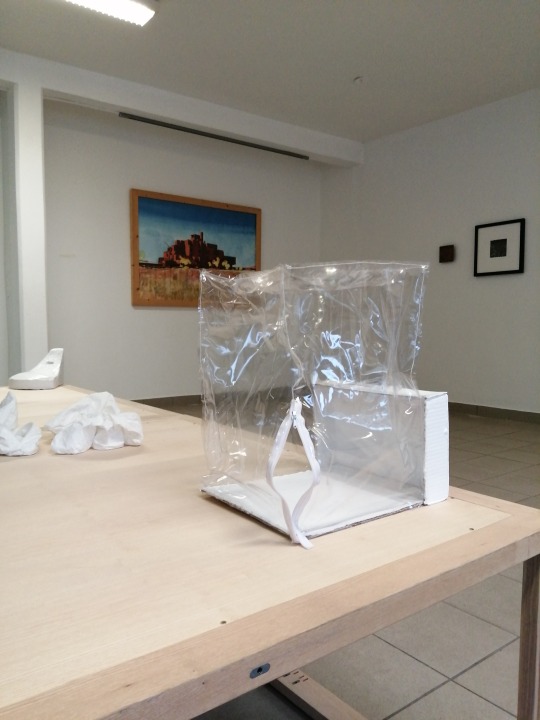
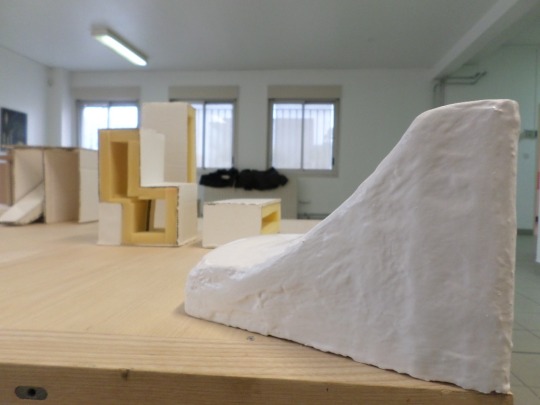
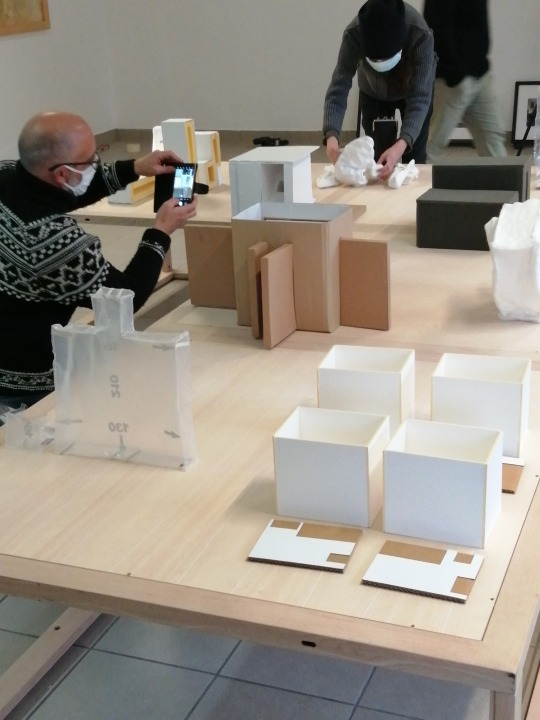

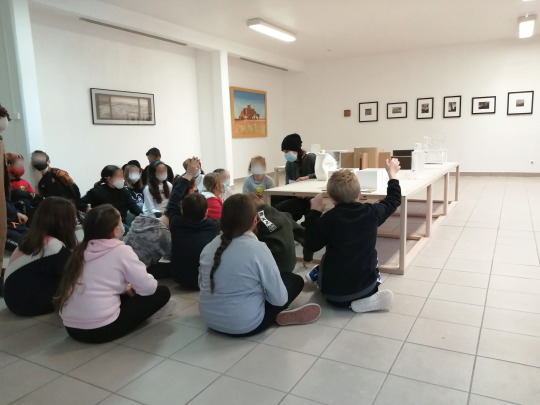
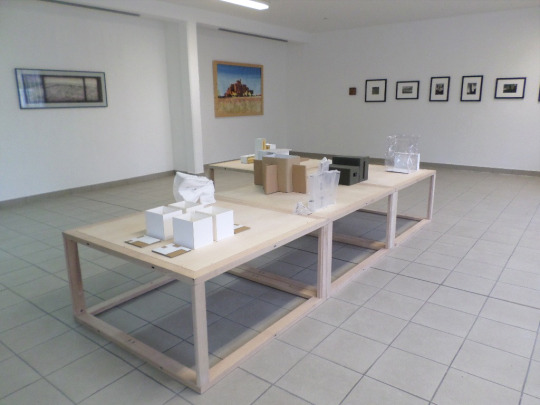
Elizabeth Creseveur - Installation architecturale ENSEMBLE DE 15 MAQUETTES / ARCHIVESPACES - 1997- 2018 - collection Frac Paca sélection de 10 maquettes + prêt maquette Cabin Fever 2020 Espaces Restreints - Propositions espace SDB - Maximum-Minimum - Surprotection 1 - ENES 1 2 3 (Espace Nécessaire Et Suffisant) - Debout Assis Couché - Protection 2/3 - Extension - S.A.S - Cabin fever
Dispositif agencement de 4 modules en fonction de l'espace - 220 x 330 x 55 cm
Lieux et utopie Espace Prairial, Vitrolles Exposition du 11 décembre 2020 au 16 avril 2021
+ infos : https://www.fracpaca.org/Lieux-et-utopie
Avec les œuvres d’ Elizabeth Creseveur, Matthieu Montchamp, Yvan Salomone, Jean-Marie Sorgue et Medhi Zannad de la collection du Frac Provence-Alpes-Côte d’Azur. Un partenariat de l’Education Nationale, de la ville de Vitrolles et du Frac Provence-Alpes-Côte d’Azur
Intervention artistique Elizabeth Creseveur 11 novembre 2020
ARCHIVESPACES cet ensemble de maquettes vient compléter le tout premier, acquis en 1997. 8 maquettes ont été réalisées à l’échelle 1 (expositions Villa Noaïlles, Biennale Design St Etienne, galerie Anne de Villepoix, Roger Pailhas, Eac Mouans Sartoux …), la majorité des pièces ont été détruites exceptées Cabines (collection MAC Marseille), Maximum-Minimum (collection Frac Paca) et Protection 2/3 (collection FNAC Paris). En regard, la maquette devient mémoire et offre un nouvel espace de projection, d’introspection et d’expérimentation.
photos © Elodie Bricout © EC/adagp
0 notes
Text
Hannah Palin x MIPoPS!
Next in our series of profiles on the people who make MIPoPS tick, we’re talking to Hannah Palin, Moving Image Curator at the University of Washington Libraries’ Special Collections. Hannah is the life of the party. She has the je ne sais quoi usually associated with actors and celebrities - always two seconds away from putting on her next character, her next accent, her next story that’ll have you rolling on the floor with tears streaming down your cheeks. She is magnetic and magnanimus. She’s also on MIPoPS Board of Directors, AND directly responsible for much of the moving image preservation infrastructure here in Washington! Hannah has been with MIPoPS from the very beginning, and we are exceptionally lucky to have her.

Hannah at one of MIPoPS Moving History screenings at the Northwest Film Forum. Ari Lavigne (AL): HIYA! Who are you? What’s your av backstory? What do you do for work? Hannah Palin (HP): Hi back atcha! At one point in my evolution, I thought I decided to explore documentary filmmaking. I had some stories to tell and wanted to delve into film and audio production as a way to get my ideas out into the world. I needed a day job and found myself at a small company that transferred film to videotape. I spent five years sitting in the dark, watching home movies, educating our customers on what kind of film they had in their shoebox and how best to take care of it. In 2001, at the urging of a local filmmaker, I attended the Association of Moving Image Archivists conference in Portland and discovered that there was whole profession devoted to sitting in the dark, watching movies, and educating people on how to preserve their moving image materials. I met Nicolette Bromberg, Visual Materials Curator at the UW Libraries Special Collections, and she gave me her elevator pitch for starting a regional film archive. I was hooked. I started volunteering, then working on grant projects, then they finally gave me a job because I just wouldn’t go away. I’ve been working on building the moving image collections at the UW ever since. AL: How did you come to be involved with MIPoPS? HP: Rachel, MIPoPS Executive Director, and I met during the Washington Film Preservation Project in 2006. The UW was awarded a preservation grant from the Washington Secretary of State’s office to work with nine other institutions in the region to help them work on their film collections, including MOHAI, the Museum of Flight, the Yakama Nation, and Seattle Municipal Archives, among others. Rachel was working with Seattle Municipal Archives at the time, so we got to know each other a bit then. A few years later, we spent time at an Association of Moving Image Archivist conference in Savannah, which led to grabbing coffee back home, which led to conversations about creating a regional film archive, which eventually led to the birth of MIPoPS and the rest is Moving Image History. Because of my responsibilities at the UW, I’ve stepped into the role of Board Member, but I’d love to come back and play more soon! AL: You are a tremendously creative person. You’ve worked on both video and audio documentaries and even been featured on RadioLab - twice! If you had all the money and all the free time in the world, what creative projects might we find you tinkering away at?

Click here to listen to "The Day My Mother's Head Exploded", a 2004 piece by Hannah. HP: Good question! At this point, I feel like a lot of my creative juices are funneled into my job at the UW, but I’ve got another project that’s beginning to take shape. My biological father was a painter and I’ve become the caretaker of his collection, which includes 400 paintings and works on paper (https://www.kennethshowell.com/). I’d like to use my curatorial skills to get his work out into the public sphere, but I think there’s also a story in there somewhere that is just waiting to take shape. One of these days! AL: You’ve personally had a hand in training or otherwise fostering the development of most of the MIPoPS staff (Libby, Andrew Weaver, and I all worked with you at UW). How important is sharing your skill set with newbies in the field? Do you have a philosophy of mentorship / teaching / sharing? HP: I definitely feel an obligation to help the next generation of folks coming up because there just aren’t a lot of opportunities to learn about moving image preservation or archives in the Pacific Northwest. So, if you can’t get to NYU, UCLA, or Eastman House (which I couldn’t do either) come hang with me and I’ll tell you what I know. I learn as much from working with students as I hope they do from me. Every collection and project is so different that there’s always something new to figure out and to do. It’s a collaboration and I’m always thrilled when folks pick up the baton and move the profession forward. My mission is to preach the gospel of moving image preservation so that we can preserve the visual heritage of this region. When I started I could say that I was the only person in the state of Washington paid to work full-time on moving image collections. Now I’m thrilled to say that that isn’t the case. FIlm and videotape are being taken more seriously by cultural institutions across the state and there’s definitely a shift in thinking about them as primary source materials that deserve care and attention. AL: What areas do you think up and coming AV archivists should be exploring?

Hannah Palin and Libby Burke working on the winds at UW. Photo: Meryl Schenker, Seattle Post-Intelligencer, 2004. HP: Even though the digital revolution has pushed the field towards bits and bytes, I think that there is a need for everyone to be a jack-of-all-trades. Maybe it’s just me, but most of us are going to be Lone Arrangers, the sole voice of expertise in any organization, and you’ve got to be able to do it all. On any given day, I might meet with a donor, work with a student on their capstone project, repair a Umatic tape or clean a deck, meet with Advancement to discuss a grant opportunity, accession a new collection using ArchiveSpace, and use bagit to prep files for storage. You’re a specialist and a generalist all the time. It can be overwhelming, but it’s imperative to know it all. AL: What material have you seen lately that really moved you? HP: We recently acquired the KIRO-TV Channel 7 News library with 15,000 tapes from 1975-2006. Last month I discovered a 14 minute film from a program produced for KIRO’s first anniversary that aired in February 1959. It’s basically a day-in-the-life of a television news station and it shares with the audience how the broadcasters spend their days getting stories on the air. Like many TV stations across the county, KIRO discarded their 16mm film library when they switched to videotape in 1975, so this film is like finding a time capsule of what local news was like at the dawn of television. I’m thrilled that it turned up, I’m happy that we had the funds to be able to get a 2K scan at Light Press, and I’m ecstatic that I get to share it with students, researchers, and producers.
AL: Is there anything in your orbit that you’d like to share? It doesn’t have to be av related! HP: It is incredibly satisfying to see how far MIPoPS has come from its beginnings, how much it has grown because of the hard work that everyone has put into the organization (you, Libby, Andrew, and Rachel deserve kudos for all that you’ve done), and, most of all, how deep an impact it is having on our region. Amazing!!! Can’t wait to see what’s next!
#MIPOPS#moving image preservation#moving image preservation of puget sound#film studies#audiovisual archives#moving image history#film archivist#university of washington#seattle#pacific northwest#hannah palin#interview
0 notes
Text
Reading Archives: La desaparición de nuestros derechos culturales (¿y el patrimonio cultural?
Al principio, Ivey señala que los “primeros archivos” a menudo eran “trabajos de amor creados por devotos fanáticos de la historia y el arte”, pero ahora “es un negocio” (p. Gran parte de la atención del autor se dedica a lo que las corporaciones han hecho a nuestro patrimonio documental). , e Ivey generalmente no tira ningún golpe. Al escribir sobre archivos de música en la industria discográfica, Ivey cree que estos archivos son mantenidos por “empleados de bajo nivel” sin darse cuenta de la importancia de lo que tienen bajo su custodia (p. organizaciones con fines de lucro que administran estos archivos también han tenido problemas: “nuestros archivos públicos y privados con fondos insuficientes han archiveros tenido problemas para mantenerse al día con la expansión de colecciones, tecnologías costosas y un entorno de propiedad intelectual cada vez más oneroso” (p. La fuente de este problema o enfoque es porque la “estrategia de preservación” se basa en el valor de mercado actual. El resultado es, en el mejor de los casos, un tamiz permeable. Algunos tesoros se guardan, pero otros se extravían, se almacenan mal ed, o encerrado en servicio para obtener ganancias ”(p. Ivey no escribe una evaluación sombría, pero propone una larga lista de acciones que deben o deben tomarse. Algunos me parecen idealistas, pero su llamado a la acción y la resistencia es algo que los archiveros deberían leer y reflexionar.
Los tiempos estaban cambiando. Los archivos todavía eran en gran parte institucionales, pero la naturaleza de los registros que recopilaron era muy diferente. Frente a una avalancha de papel en la creciente crisis de los registros contemporáneos, los archiveros ya no podían retener responsablemente el “todo”, como lo expresó el Manual (y Foucault, podría agregar), de cualquier cosa. La teoría de los archivos respondió cambiando de centrarse en la preservación de los registros a la selección de registros para su preservación. También abogó por trabajar con investigadores para determinar qué registros tenían un valor secundario. Creo que es un desarrollo bastante emocionante en esta historia, aunque en su tiempo “investigadores” en realidad solo se refería a “historiadores”, lo siento mucho gente de humanidades digitales. Schellenberg ha influido en muchos archiveros, especialmente en los Estados Unidos e incluyéndonos en el Bentley. Y luego vino la revolución digital. Análogo a la Revolución Agrícola y la Revolución Industrial, la Revolución Digital marcó el comienzo de la era de la información. No es necesario decir que la Revolución digital ha tenido un profundo efecto en la naturaleza y el tratamiento de los archivos en la sociedad contemporánea, así como en su uso.
Y esto es de esperar, porque el contexto mismo que produjo el Manual y las obras de Jenkinson ha cambiado fundamentalmente. Entonces, el contexto ha cambiado fundamentalmente … pero espera, hay más. Los registros mismos también han cambiado fundamentalmente. Los registros digitales (el material real que se archiva) son mucho más frágiles que sus contrapartes físicas, y tenemos menos experiencia con ellos. ¡La preservación digital es un desafío! Realmente no quiero entrar en todo eso aquí. Entonces, como profesión, comenzamos a pelear. Adoptamos y creamos modelos, por ejemplo, como el Modelo de referencia del Sistema de información de archivo abierto (OAIS) y el Modelo de ciclo de vida de curación DCC para informar los sistemas y el trabajo que hacemos. Es lo que pretende ser). Entonces, ¿dónde nos han dejado estos desarrollos? En cuanto a la tecnología, tal vez sea a mediados de la década de 2000. Los curadores digitales a menudo se quejan de que la tecnología que hemos creado para tratar con archivos digitales parece estar unos 10 años por detrás de los propios archivos.
Sin embargo, en teoría de archivo, probablemente sea más como 1924, con el Manual y Jenkinson, con procedencia, orden original y evidencia imparcial. OK, me gustaría comenzar a terminar esto. Dos cosas y luego he terminado. El primero es que el proyecto de integración de flujo de trabajo ArchivesSpace-Archivematica-DSpace definitivamente está superando los desafíos de conservación y conservación digital, y lo está haciendo de una manera novedosa que vuelve a alinear la práctica archivística contemporánea con la teoría archivística contemporánea. Para ser honesto, la división de Curation (anteriormente Curation Digital) en Bentley ya tenía una sólida reputación reconocida a nivel nacional por esto, pero por un efecto dramático, ¡solo pretenderé que todo esto es gracias a nuestro proyecto! La disposición de esta nueva funcionalidad también es realmente emocionante. Ayuda a abordar el problema de control colectivo que describí anteriormente al permitir a los archiveros crear arreglos intelectuales y asociarlos con objetos de archivo de ArchiveSpace de una manera bastante sofisticada, en conjunto, con API y todo. Realmente, esto es algo genial!
Cuando termine la subvención, ¿dónde estaremos? Realmente quería terminar esta charla afirmando que nuestro trabajo nos deja (a nosotros en Bentley y a nosotros como profesión) en un mejor lugar para servir a usuarios como usted. Y lo hace Ya estábamos ayudando a mitigar todos esos riesgos para todo lo que entra por nuestra puerta, asegurándonos de que esté disponible y sea utilizable para las generaciones futuras. Al final de este proyecto lo haremos aún mejor de lo que estamos ahora. Pero, si soy sincero, en realidad no estoy completamente seguro de que este proyecto nos deje en un lugar para servir mejor a los usuarios o, como lo llamamos, para proporcionar “acceso”, al menos no directamente. En realidad, y estoy tratando de pensar críticamente aquí, lo que hace es hacernos la vida más fácil. Pero hay algunas buenas noticias. Estamos mejorando sobre esto. Bentley está dedicando mucho tiempo y recursos a algunas iniciativas interesantes para proporcionar un mejor acceso a nuestros materiales, tanto físicos como digitales, obtener audio y video en línea, y para involucrar a los usuarios que tradicionalmente no hemos involucrado.
from WordPress https://interiorismohoy.wordpress.com/2020/04/22/reading-archives-la-desaparicion-de-nuestros-derechos-culturales-y-el-patrimonio-cultural/
0 notes
Text
Competence 3: Organization of Recorded Knowledge and Information
3A. The principles involved in the organization and representation of recorded knowledge and information.
3B. The developmental, descriptive, and evaluative skills needed to organize recorded knowledge and information resources.
3C. The systems of cataloging, metadata, indexing, and classification standards and methods used to organize recorded knowledge and information.
The entire process of developing the Paul Zia Papers collection began with me first having to sort through the cartons of donated materials from Dr. Zia. The process of looking through the materials, organizing them into series and then folders and finally storing them in their archival boxes was one that demanded a lot of my own judgement, which was intimidating. I had to think about what materials were complementary as well as how to organize it in a user-friendly way. The first step in making the chaos of donated materials into something that can be used by researchers was the handling and preservation. The second step was to enter them in ArchiveSpace so that researchers and Special Collections staff can access the materials. In doing so, to create the scope and content for the collection, I investigated Zia’s biography and accomplishments as well as the history of the Cape Hatteras Lighthouse move to ensure that I was not only providing a credible abstract for researchers, but also a captivating one. This taught me how uniform electronic resources must be to make the materials accessible to researchers and so that it is effectively communicated to the rest of the department. After receiving suggestions from Linda about what to improve, I had the satisfaction of publishing the collection for researchers to access.
0 notes
Text
The Backlog
As I mentioned in my previous post, I have to start doing the Internship log on my own. Technically, I should have started doing that like two weeks ago. So! Here’ the backlog of stuff that I’ve been doing!
These are the logs from August 21st, to September 4th, in order.
Tuesday, August 21, 2018
After a week long break, I came back, and worked in the Vault pretty much the whole day, working on cataloguing the extents of our Archdiocese collection, which we are working on getting under control. I finished up the remainder of the collections that needed cataloguing, and so my new advisor, B we shall call her, started me working with ArchiveSpace, particularly putting in all of the data we had been collecting about each box into archive Space. It took a little bit, but I began to get the hang of it. New things still freak me out though, especially when it’s new things that are actually going to be used by people.
Wednesday, August 22, 2018
A day off of my normal schedule, so I could try and get home to see people before school started. This time, I measured each of the shelves our Archdiocese collection, because we are trying to put each section of the collection together and in order, which they aren’t now. this is a huge task, and is going to take a lot of man hours just to physically move everything. So the shelves needed to be measured so that we don’t try to fit a giant box on a shelf half its size. I finished up that, and also finished up the drafts for my online exhibit! I put them up, and knew I would need a little more time to finish them, but the bulk of the work was done.
Tuesday, August 28th, 2018
School started this week, so my work was limited to just two hours in between classes on this day. However, this time was used to put the finishing touches on some of the pages on that online exhibit I’ve been a part of, get them set up format wise, set up the pictures and source the pictures, and put together everything before things need to be sent to the printers on Friday. I put stuff together for the best of my ability as the bulk of my day.
Friday, August 31st, 2018
My Ultimate Boss (tm), named S, wanted me to come in, because it was the day where things for the exhibit were going out to the printers. She wanted me to re-do some of my original pages for the exhibit, since the one I had put together, while interesting, didn’t really fit as well. I get that, looking back, I was honestly most excited about that page because it was about specific monasteries of a monastic order, one of which I had visited. I had a personal bias. The page she had me put together, on the rise of the order, made much more sense. She also had me put together a page on one of the nuns in the sister order, which was super interesting! Overall I worked on those for three hours, and all that was left was getting the citations for the pages in.
Tuesday, September 4th, 2018
The current day! today I’m mostly working on three things- collecting the sources for my online articles, putting together THIS internship log, and having a meeting with my tragically soon-not-to-be advisor, who shall be named A. She reminded me that I should be doing these in the first place, so I’ve set this up in a diary/blog format thing, so I can look back on it later. So far, my biggest worry about the citations is what format to do them in, since people get very nervous about proper citations. I’m going to ask S about it, before my meeting with A an B.
1 note
·
View note
Text
Student Internship: Lindsey Bosak
Working with Arizona State University’s Chicano/a Research Collection was an opportunity unlike any I have had before. Nancy ensured my semester as an intern was both educational and entertaining, as well as entirely hands-on! Arguably one of the most memorable aspects of my semester was the time spent working on and discussing community outreach. When working with an inherently underrepresented group, significant effort has to be put towards obtaining collections through donations, in addition to educating those donors on the importance of the work archivists do. Hosting open houses and tours – inviting donors and their families – is one of the best ways to share information about not only the collections but the steps archivists take to ensure records and artifacts are properly preserved. Being able to assist during one of these events was eye opening and highlighted the fact that outreach and community relations are a significant portion of an archivist’s day-to-day life.
Throughout the months I spent with the majority of my time creating preliminary inventories, re-housing, and entering collections into ArchiveSpace. Going through this process from inventory, to re-housing, to data input gave me the chance to experience a large portion of the lifecycle of a collection. I saw firsthand the variety of conditions in which a collection might arrive after donation, be it reports neatly organized in binders or simply loose papers and artifacts stacked in boxes. Working with ArchvieSpace was also enlightening in terms of availability for those interested in the collections. In the coming years I am looking forward to working further with the digitalization of collections – and subsequent organization of those records – in order to gain better understand that aspect of community access. I do believe the Library and Information Sciences field is evolving technologically, and the digital world will come to play an even more significant role in both the preservation and viewing of archival collections.
Aside from inventory and data input, I was also able to do some hands-on work with a collection of records containing mold. As was explained up front, mold removal is one of the unfortunate but necessary duties for archivists working with collections donated by individuals with little or no archival background. Experiences like this one served to remind me that collections come to archives in all manner of states, ranging from pristine to water damaged and even illegible due to weathering and improper storage. As such, once received it is the responsibility of the archivist to re-house each record according to a standard practice so they will be preserved for future use. The work done by archivists is truly invaluable, for it is through their efforts that we are able to document the world’s history – its people and their stories – for those generations yet to come.

1 note
·
View note
Photo


Memory / Format / Shift, 2015
David Greenhalgh performance with Luke O’Donnell and Hana Hoogedeure
Archive _, Sydney
1 note
·
View note
Text
Reflection
LIBS 6992 Academic Internship Reflection
Mollie B. Frazier
Throughout the Fall 2019 semester of the Master of Library Science program at East Carolina University, I was fortunate to work with Linda Sellars, Head of Technical Services for Special Collections at North Carolina State University, and Laura Lumb, Media Specialist at North Ridge Elementary School in Raleigh. Working at both sites and with two librarians whose jobs require different expectations from one another gave me insight into how much responsibility comes with the role in addition to practicing good librarianship.
For my 95 hours, which was focused in my academic concentration, I worked with Linda at the Satellite Shelving Services of Special Collections. I worked as a graduate desk assistant for Special Collections at N.C. State while I was in school, but I only saw the finished products of the collections. For the internship, I saw all that goes into processing, from appraisals to preservation, and cataloging to biographical research. I had no idea how large the processing facility was until Linda gave me a tour on my first day. She walked me through the rows of archival boxes, tubes, donated materials, and more. Then, she assigned me the collection I would be working on, which was of Professor Emeritus Paul Zia, who was the first Asian-American professor at the university and is praised for his work with reinforced concrete and the Cape Hatteras Lighthouse Move.
The process of looking through the materials, organizing them into series and then folders and finally storing them in their archival boxes was one that demanded a lot of my own judgement, which was intimidating. I had to think about what materials were complementary as well as how to organize it in a user-friendly way. Moreover, I was handling materials, such as Chinese scrolls, that required advising from the preservationist. I learned how to roll blueprints, maps, and store these scrolls. This was the first step in making the chaos of donated materials into something that can be used by researchers. The second step was to enter them in ArchiveSpace so that researchers and Special Collections staff can access the materials. In doing so, to create the scope and content for the collection, I investigated Zia’s biography and accomplishments as well as the history of the Cape Hatteras Lighthouse move to ensure that I was not only providing a credible abstract for researchers, but also a captivating one. This taught me how uniform electronic resources must be to make the materials accessible to researchers and so that it is effectively communicated to the rest of the department. After receiving suggestions from Linda about what to improve, I had the satisfaction of publishing the collection for researchers to access.
In addition to processing a collection, I was invited to attend a Special Collections staff meeting in which the staff discussed the mission of the library and the goals they created to accomplish this. They discussed the nomenclature of the goals to ensure it was inclusive and set timelines for when they wanted to achieve these goals. Similarly, I participated in a project forum and had the opportunity to talk about the Paul Zia collection as well as the projects I was working on as a graduate desk assistant. Having the platform to discuss my accomplishments and hear those of others was encouraging and clarified how dedicated everyone was to the work that they do. Everyone is busy with their own goals, but we all come together to support one another.
I also interviewed Gwynn Thayer, Associate Head of Special Collections and Curator, which was extremely insightful into the career of librarianship. She told me about the route she took, which involved some bumps in the road and some change of heart about what she wanted out of her education and work, which I believe everyone has experienced before. It was inspiring to hear that she found a position that fulfills what she wanted to dedicate her life to. She also left me with good advice about the data-driven future of academic libraries and advised me that those technical skills are going to be necessary ones to know in the future.
Lastly, I attended a student film presentation at James B. Hunt Library, part of NCSU Libraries. The event was hosted by the libraries and different colleges within the university, indicating that the libraries work with different colleges and departments within the institution. Communication must be established to make events like this happen. This also gave me an opportunity to explore the massive library and look at the BookBot where library materials, including some archival materials, are stored. This exposed me to how all the libraries in an institution are related and must worked together as a well-oiled machine.
For my 15 hours, Laura Lumb hosted me at the elementary school’s media center. I was glad that Laura was willing to work with me, as this is the elementary school I attended, albeit completely reconstructed, but I did get to see teachers I had many years ago. Having my work focused on adult learners, it was quite a culture shock to see how school libraries function. The first few days involved observing and assisting with the students and the latter days including planning and performing my in-service initiative, which was on internet safety and digital citizenship. To plan for my in-service initiative while I was observing, I took note of the lesson plan and how Laura excelled in time management. She explained to me about how long she can maintain the students’ attention, which is about 15 to 20 minutes, and what activities they like best to help me plan my presentation. I followed her plan of a presentation, which involved participation, followed by an activity that the students had to turn in before they could check out books or continue the Google Internet safety program they had been using, in which they play games to learn. I ran into some problems during part of my presentation involving the game “telephone” in which the students were to start in the line with the phrase I provided, “guppy in a shark tank”, and we would see if the ending message was the same as they whispered it to the next person. The intention of the game was to show the students how they may post something on the Internet with good intentions, but that post may be misinterpreted into something malicious or fall into the wrong hands. That point was proven in an unfortunate way when one of the kids changed the word to something foul.
Although this did not go as planned, it taught me two things: 1. When working with others, particularly children, expect the unexpected and 2. When Laura had to discipline the student, I realized that school librarians act as a librarian, a teacher, and an authority. Moreover, in the mornings before the students got to school, the teachers would come in to ask Laura technology questions, even though that is not a requirement of her position. Regardless, she was happy to help because all members of the staff work together for the overall success of the school and to ensure the children are getting the best education.
Overall, from both my experiences, one of the most impressionable things I learned was about how interactive the librarian is within the university or school. They must communicate with teachers, other faculty, deans, students, parents, and more. A well-functioning library is an integral part of an institution’s success and the librarian wears many hats. The exposure I have had to all sides of librarianship through this internship has only further solidified my yearning to become a librarian and dedicate my career to contributing to education and being part of an environment that allows others and myself to thrive.
0 notes
Photo







ARCHIVESPACES (ENSEMBLE 9 MAQUETTES) ACQUISITION FRAC PACA 2018 INSTALLATION + SPACES (ENSEMBLE 6 MAQUETTES) COLLECTION FRAC PACA. MARSEILLE JULY 2018 THANKS LAURA BAYOD, MIREN BERECIBAR.
Set of 9 models - ARCHIVESPACES - collection Frac Paca Marseille, acquisition 2018.
This set of models completes the first one, acquired in 1997. 8 models were made at the scale 1 (exhibitions Villa Noaïlles, Biennial Design St Etienne, Anne de Villepoix Gallery ...), the majority of the pieces were destroyed except Cabins (collection MAC Marseille), Maximum-Minimum (collection FRAC Marseille) and Protection 2/3 (FNAC Paris collection). In comparison, the model becomes memory and offers a new mental and physical space of projection and experimentation.
« Body and Graphy » : human’s inscription in space. A body and a space, that is how I consider the habitat and its occupant. An interior as a whole where all action, position, execution, are means of inscription of the body, means of inhabiting.
« Elizabeth Creseveur's « Set of Models » is a heterogeneous collection of small architectures, imaginary, mental projection support. An intriguing village creates unusual situations for the human body. It shows potential movements in a given space that refers to the habitat. Dreamlike, those spatial and behavioral researchs draw choreographies, by the way the body could fit into space. All figures are possible in this hypothetical world modulated by material effects such as transparency or opacity, with architectural effects made of high, low ceilings, slopes, high angularity or strict roundness, labyrinths, landings imaginary that induce effects of ascent, or on the contrary of crushing etc. It thus seems possible to register in a place, to invest in it and thus to live in it without it depending on the goods that could be disposed of, to mark a human occupation. The architecture of the habitat is not simply a shelter for man, but reveals its physical dimension as a pure space with which the body can weave an almost intimate relationship. » (…) Extract CP Exhibition « Absolumental » Frac Midi Pyrénées Museum of Contemporary Art Les Abattoirs Toulouse.
Set of 6 models - SPACE PROPOSITIONS I - Frac Paca Marseille collection. Set of 24 models - SPACE PROPOSITIONS II - Frac Midi Pyrénées collection.
0 notes
Photo






ARCHIVESPACES ensemble de 9 maquettes 2010 - 2018 collection FRAC PACA
0 notes